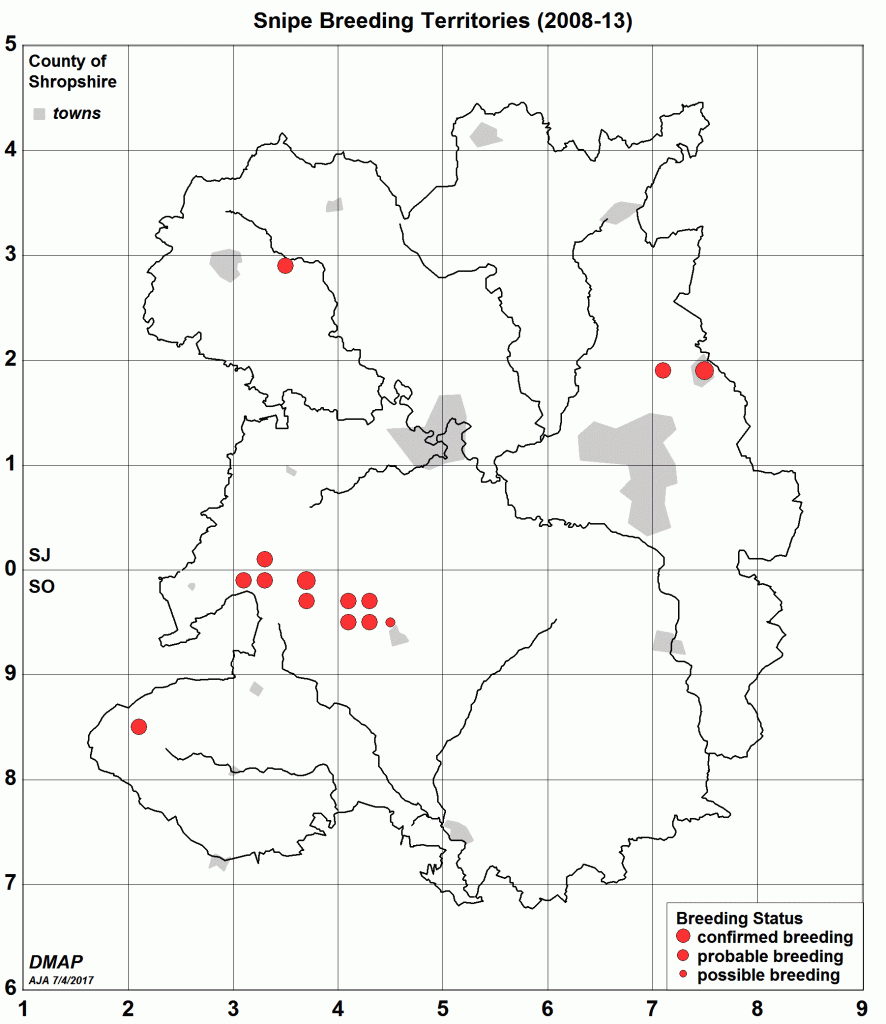Breeding Birds of Conservation Concern in Shropshire
Species Action Plan
Snipe
Status
Fairly common winter visitor, rare breeding species
Shropshire: Red List
National (BoCC4): Amber List
Breeding population estimate from 2019 survey: 10 territories (pairs)
Distribution (geographic and habitat requirements)
Each breeding pair needs an extensive area (10 -15 ha) of very wet ground (usually indicated by the presence of Sphagnum Moss).

The distribution map from the 2008-13 Atlas.
Population trend
There were 11 confirmed breeding records in the 1985-90 Atlas, but only two in 2008-13 (from farmland near Newport in 2009, and farmland near the Stiperstones in 2013).
Between the two Atlas periods, breeding Snipe were reported from several sites. Based on fieldwork between 1994 and 1998, the Long Mynd BBP estimated the population at 20–25 pairs (Smith SBR 2003). One was found on the Stiperstones NNR in 1995, and two on adjacent farmland, including a nest (Cross & Moscrop 1996). One was drumming and displaying at Whixall Moss in mid-June 1995, and there were reports from several sites around Newport, some of which are shared with Staffordshire, including three drumming east of the town in April and May 1996, two drumming and a juvenile on the ground in early July 1996 at Norbroom Marsh, one on a nest in the same place in May 2005, and one chipping at the Sewage Works in May 2004. Other locations with breeding evidence were Beckmoor (one territory in 1999, a nest with four eggs found), a nest with eggs and an adult feeding young at Bow Farm (Lydham) in the same year, one drumming at Rhos Fiddle in mid-May 2005 and one calling repeatedly at Pen-yr-estyn in early May 2006.
Monitoring (survey methods and frequency)
Only surveys to listen for drumming males at dusk from late April onwards produce reasonable results. Results may be confused by passage migrants (known to drum and chip).
All sites with breeding season records since 2000 have been surveyed every five years, starting in 2009 (following the first survey in 2004, restricted to the south-west hills). Whixall Moss was surveyed at dusk in 2009 and 2014, but not 2019. However, local birders reported drumming and chipping Snipe from 2017. Sites around Newport (listed above) were also covered in all three dusk surveys, but none were found. Black Mountain (Clun Forest) was omitted from the 2019 survey, as there have been no records since 2004.
Detailed instructions for surveyors have been provided since 2009, and are considered to work well. They will be reviewed annually, before the start of the season.
Results of dusk counts for the Breeding Snipe survey
A territory at Whixall Moss was also found by local birders, increasing the population estimate to 10 territories / pairs. The report of the Breeding Snipe Survey 2019 can be found elsewhere on the SOS website.
BTO are planning to repeat the Birds of Wet Meadows survey in 2021.
It is intended to repeat the Breeding Snipe Survey in 2024. Any new sites with breeding season (late April – mid June) records between now and then will be added to the survey.
Reasons for decline
“Declines are linked to agricultural intensification and the drainage of wet tussocky grassland . . . management of water levels can increase breeding density” (BTO Atlas 2007-13)
Decline on Long Mynd was attributed by the Ground-nesting Bird Recovery Project to predation, and encroachment of increasingly dense soft rush on the wet flushes was identified by NT.
Disappearance from Rhos Fiddle may have been partly due to over-grazing
Actions towards recovery
Habitat Improvements have increased the number of breeding pairs / sites since 2009:-
- Control of soft rush on Long Mynd (RSPB advice to National Trust), and digging scrapes.
- Raise water levels to create permanently wet enclosures (BogLIFE project at Whixall Moss, from 2017)
- Block old drains (together with rush control, at Stiperstones)
There is scope to increase the number of territories at all three of these sites, by extending management work to other areas. The landowners should be encouraged to do this, and advice offered.
Reducing predation, by reducing the food supply for predators and scavengers in the wider landscape (removing fallen stock, especially sheep, and substantially reducing the massive number of Pheasants released annually for shooting each year – 726,000 in 2018 alone), would benefit several ground-nesting bird species, including Snipe.
Constraints to delivery of actions
Finding volunteers to survey a crepuscular species
Management resources available to landowners
Targets
Starting in 2021
- Review the “Instructions to Surveyors” before the season starts, and recruit surveyors
- Survey sites with breeding Snipe annually, preferably at dusk
- Encourage landowners to apply the “Actions towards recovery” above on all suitable parts of their site
- Encourage SWT (owner of Rhos Fiddle) and Powys Estate (owner of Stapeley Common) to also implement the actions towards recovery
- Ensure coverage of all possibly suitable breeding sites in the BTO Birds of Wet Meadows survey
Future years
- Survey any additional site where “Actions towards recovery” are carried out
- Repeat the Breeding Snipe Survey every five years, starting in 2024
Relevant non-SOS projects
- RSPB Species Recovery Action Plan
Leo Smith
Species Champion
October 2020
Back to Breeding Birds of Conservation Concern in Shropshire & Species Recovery Action Plans.
